The Other Oil Spill
Air Date: Week of July 16, 2010

Plastic particles. (Photo: Sea Education Association—Leslie Peate)
You may have heard of the plastic trash vortex in the North Pacific Ocean. It’s a region where wind and ocean currents cause plastic to accumulate by the ton. But it turns out that the North Pacific isn’t the only ocean with a plastic problem. Host Jeff Young talks with Giora Proskurowski, an oceanographer with the Sea Education Association, about his recent exploration of the plastic vortex in the North Atlantic.
Transcript
YOUNG: The gusher in the Gulf isn't the only "oil" fouling the sea. Plastic trash, which is also petroleum-based, is plaguing the world's oceans in record amounts. Most of us have heard of the Great Pacific Garbage Patch. Its’ strange glut of plastic has been likened to a toilet that never flushes. But the North Pacific isn’t the only ocean with a plastic problem. Researchers from the Sea Education Association in Woods Hole, Massachusetts have just returned from a month-long expedition into the plastic trash of the North Atlantic. Chief scientist Giora Proskurowski is on the phone from Bermuda – where the research ship just docked – welcome to Living on Earth!
PROSKUROWSKI: Thank you, my pleasure.
YOUNG: Well, tell me about the expedition. What were you doing out there?
PROSKUROWSKI: Well, we’ve been sampling in this region from Woods Hole to Bermuda and then to the Caribbean in the western Atlantic for 25 years or so. And what we proposed to do was to go far east from Bermuda where we know that plastics exist in the ocean, and try to find the eastern boundary of this region of high concentration in the ocean. And, we were hoping to see diminishing plastic concentrations, but what we actually saw, and actually our very eastern-most surface tow, was where we found the highest concentrations of plastic that have ever been observed in any of the world’s oceans.
YOUNG: How much plastic are we talking about?

A trawling net. (Photo: Sea Education Association—David M. Lawrence)
PROSKUROWSKI: Well, so what we do typically is we put a net in the water, a surface net, that filters about 4,000 bath-tubs worth of surface water, and what we found that was in our nets that we towed for half an hour, or a nautical mile, was 23,000 pieces of plastic. And these are very small fragments, the size of, you know, a fiber, maybe a centimeter long, the thickness of a hair or a piece of just a fragment of plastic the size of a pencil eraser or smaller. And we found 23,000 of those in our net tow, which turns out to be 26 million pieces of plastic per square kilometer.
YOUNG: That’s astounding.
PROSKUROWSKI: And that’s discounting all the macro debris, the larger debris, that we saw. On that day, which was sort of a dispiriting day, although it was very exciting for our expedition, all of a sudden we got very flat water and we saw just, lots of large floating debris. And, all of a sudden our nets were in the water and we just got massive… it was like sand drifts of plastic in our sieves where we process them- it was pretty upsetting.

Plastic fragments. (Photo: Sea Education Association—Marilou Maglione)
YOUNG: And this is a record?
PROSKUROWSKI: I believe so. SEA’s been doing this research for 25 years and this is a hundred times more than we’ve ever got in any of our net tows. I know there was an expedition out in the Pacific last year and I think they got a million, or four million was their highest per square kilometer. So using that same metric, this was still about ten times more than what anybody’s ever seen. And, I’d always sort of thought that the Atlantic had maybe less plastic than the Pacific, and that’s typically what you hear, but from our findings on this trip, there’s really not that much difference at all.
YOUNG: Now, you’ve been in these “trash vortex areas,” as they’re sometimes called, in both the Atlantic and the Pacific. Why do these things happen where they happen?
PROSKUROWSKI: That’s a good question. It’s a very good way to learn about the Earth that we live on and it comes down to the basic simple physics that we live on a rotating, spherical body, that’s unevenly heated at the equator. So, the sun heats the water at the equator, that air rises, it becomes less dense and rises with the humidity, and what happens is it moves north or south, and it cools a little bit, and it happens to be that both 30 degrees north latitude and 30 degrees south the air starts to sink and you get these large regional areas of high atmospheric pressure and that’s what’s known as the Bermudan high- that’s why it’s really sunny out there today- and these regions of high pressure are associated with low winds and low currents.
And, so, once floating debris starts to get in the ocean they sort of drift slowly to these regions and then they stall out because of the low winds and slow currents and there’s no really forcing to get them out of this region, they just slowly accumulate.

The Sea to Education Association vessel (Photo: Sea Education Association)
YOUNG: So it’s more or less in the same spot in the Pacific as in the Atlantic when you look at where it is in relation to the equator.
PROSKUROWSKI: Yeah, exactly. So it’s 30 degrees latitude both north and south, and it’s not just the north Pacific or the north Atlantic, it’s the south Pacific and south Atlantic and the Indian Ocean as well. Anywhere where there’s a large ocean basin centered at 30 degrees you’ll get this same phenomenon.

A Neuston Tow. (Photo: Sea Education Association—Leslie Peate)
YOUNG: And, I’m wondering, when you haul up 23,000 pieces of plastic in a single scoop, more or less, what do you think about us when you’re out there looking at all that plastic? And what we’re doing to the oceans just through tiny little pieces of consumption, pieces of plastic?
PROSKUROWSKI: Yeah, the ocean’s not supposed to have any plastic, and yet we were pulling it out like we were a recycling center. It definitely forces you to confront how humans interact with the environment and how we’ve changed it. And, I think in these days of people doubting global warming because you can’t physically see it or observe it with your eyes- this is an example. And, I think that’s one reason why it resonates with so many people, is because we can be 2,500 miles from land and pull out 23,000 pieces of plastic and it is our habits of one-use consumer plastics that’s doing this.
YOUNG: Giora Proskurowski with the Sea Education Association, thanks very much!
PROSKUROWSKI: Thank you very much, it’s my pleasure to be here.
YOUNG: For pictures of plastic trash in the North Atlantic and more about Sea Education Association's expedition, go to our website, loe.org.
Links
Living on Earth wants to hear from you!
Living on Earth
62 Calef Highway, Suite 212
Lee, NH 03861
Telephone: 617-287-4121
E-mail: comments@loe.org
Newsletter [Click here]
Donate to Living on Earth!
Living on Earth is an independent media program and relies entirely on contributions from listeners and institutions supporting public service. Please donate now to preserve an independent environmental voice.
NewsletterLiving on Earth offers a weekly delivery of the show's rundown to your mailbox. Sign up for our newsletter today!
 Sailors For The Sea: Be the change you want to sea.
Sailors For The Sea: Be the change you want to sea.
 The Grantham Foundation for the Protection of the Environment: Committed to protecting and improving the health of the global environment.
The Grantham Foundation for the Protection of the Environment: Committed to protecting and improving the health of the global environment.
 Contribute to Living on Earth and receive, as our gift to you, an archival print of one of Mark Seth Lender's extraordinary wildlife photographs. Follow the link to see Mark's current collection of photographs.
Contribute to Living on Earth and receive, as our gift to you, an archival print of one of Mark Seth Lender's extraordinary wildlife photographs. Follow the link to see Mark's current collection of photographs.
 Buy a signed copy of Mark Seth Lender's book Smeagull the Seagull & support Living on Earth
Buy a signed copy of Mark Seth Lender's book Smeagull the Seagull & support Living on Earth

